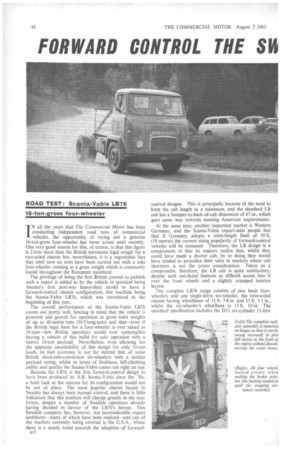FORWARD CONTROL THE 814
Page 46

If you've noticed an error in this article please click here to report it so we can fix it.
IN all the years that The Commercial Motor has been conducting independent road tests . of commercial vehicles, the opportunity of trying out a genuine 16-ton-gross four-wheeler has never arisen until recently. One very good reason for this, of course, is that this figure is 2 tons more than the British maximum legal weight for a two-axled chassis but, nevertheless, it is a regrettable fact that until now no tests have been carried out with a solo four-wheeler running at a gross weight which is commonly found throughout the European mainland.
The privilege of being the first British journal to publish such a report is added to by the vehicle in question being Sweden's first post-war heavy-duty model to have a forward-control chassis configuration, this machine being the Scania-Vabis LB76, which was introduced at the beginning of this year.
The overall performance of the Scania-Vabis LB76 comes out pretty well, bearing in mind that the vehicle is powered and geared for operation at gross train weights of up to 40 metric tons (39.5 long tons) and that—even if the British legal limit for a four-wheeler is ever raised to 16 tons—few British operators would ever contemplate buying a vehicle of this build for solo operation with a (mere) 10-ton payload. Nevertheless, even allowing for the apparent unsuitability of this design for only 10-ton loads, its fuel economy is not far behind that of some British third-axle-conversion six-wheelers with a similar payload rating, whilst in terms of liveliness, hill-climbing ability and quality the Scania-Vabis comes out right on top.
Because the LB76 is the first forward-control design to have been produced by A.B. Scania-Vabis since the -30s, a brief look at the reasons for its configuration would not be out of place. The most popular chassis layout in Sweden has always been normal control, and there is little indication that this position will change greatly in the near future, despite a number of Swedish operators already having decided in favour of the LB76's layout. This Swedish company has, however, not inconsiderable export ambitions—many of which have been realized—and one of the markets currently being coveted is the U.S.A., where there is a steady trend towards the adoption of forward
a12 control designs. This is principally because of the need to keep the cab length to a minimum, and the standard LB cab has a bumper-to-back-of-cab dimension of 67 in., which goes some way towards meeting American requirements.
At the same time, another important market is Western Germany, and the Scania-Vabis export-sales people feel that if Germany adopts a train-length limit of 59 ft. (18 metres) the current rising popularity of forward-control vehicles will be stemmed. Therefore, the LB design is a compromise in that its makers realize that, whilst they could have made a shorter cab, by so doing they would have tended to prejudice their sales in markets where cab shortness is not the prime consideration. Taken as a compromise, therefore, the LB cab is quite satisfactory, despite such out-dated features as difficult access into it over the front wheels and a slightly cramped interior layout.
The complete LB76 range consists of two basic fourwheelers and one single-drive six-wheeler, the twin-axled chassis having wheelbases of 11 ft. 3.8 in. and 15 ft. 1.1 in., whilst the six-wheeler's wheelbase is 15 ft. 10 in. The standard specification includes the D11 six-cylinder 11-litre




























































































